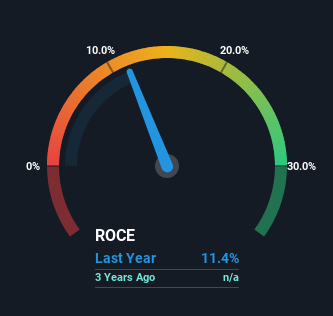- Saudi Arabia
- /
- Metals and Mining
- /
- SASE:9563
There Are Reasons To Feel Uneasy About BENA Steel Industries' (TADAWUL:9563) Returns On Capital

If we want to find a stock that could multiply over the long term, what are the underlying trends we should look for? One common approach is to try and find a company with returns on capital employed (ROCE) that are increasing, in conjunction with a growing amount of capital employed. Put simply, these types of businesses are compounding machines, meaning they are continually reinvesting their earnings at ever-higher rates of return. However, after investigating BENA Steel Industries (TADAWUL:9563), we don't think it's current trends fit the mold of a multi-bagger.
What Is Return On Capital Employed (ROCE)?
Just to clarify if you're unsure, ROCE is a metric for evaluating how much pre-tax income (in percentage terms) a company earns on the capital invested in its business. To calculate this metric for BENA Steel Industries, this is the formula:
Return on Capital Employed = Earnings Before Interest and Tax (EBIT) ÷ (Total Assets - Current Liabilities)
0.11 = ر.س12m ÷ (ر.س281m - ر.س180m) (Based on the trailing twelve months to June 2023).
Thus, BENA Steel Industries has an ROCE of 11%. On its own, that's a standard return, however it's much better than the 6.5% generated by the Metals and Mining industry.
See our latest analysis for BENA Steel Industries

While the past is not representative of the future, it can be helpful to know how a company has performed historically, which is why we have this chart above. If you'd like to look at how BENA Steel Industries has performed in the past in other metrics, you can view this free graph of BENA Steel Industries' past earnings, revenue and cash flow.
What Can We Tell From BENA Steel Industries' ROCE Trend?
On the surface, the trend of ROCE at BENA Steel Industries doesn't inspire confidence. Over the last two years, returns on capital have decreased to 11% from 27% two years ago. Although, given both revenue and the amount of assets employed in the business have increased, it could suggest the company is investing in growth, and the extra capital has led to a short-term reduction in ROCE. And if the increased capital generates additional returns, the business, and thus shareholders, will benefit in the long run.
On a separate but related note, it's important to know that BENA Steel Industries has a current liabilities to total assets ratio of 64%, which we'd consider pretty high. This can bring about some risks because the company is basically operating with a rather large reliance on its suppliers or other sorts of short-term creditors. While it's not necessarily a bad thing, it can be beneficial if this ratio is lower.
The Key Takeaway
In summary, despite lower returns in the short term, we're encouraged to see that BENA Steel Industries is reinvesting for growth and has higher sales as a result. And there could be an opportunity here if other metrics look good too, because the stock has declined 15% in the last year. So we think it'd be worthwhile to look further into this stock given the trends look encouraging.
If you want to know some of the risks facing BENA Steel Industries we've found 5 warning signs (2 don't sit too well with us!) that you should be aware of before investing here.
For those who like to invest in solid companies, check out this free list of companies with solid balance sheets and high returns on equity.
If you're looking to trade BENA Steel Industries, open an account with the lowest-cost platform trusted by professionals, Interactive Brokers.
With clients in over 200 countries and territories, and access to 160 markets, IBKR lets you trade stocks, options, futures, forex, bonds and funds from a single integrated account.
Enjoy no hidden fees, no account minimums, and FX conversion rates as low as 0.03%, far better than what most brokers offer.
Sponsored ContentValuation is complex, but we're here to simplify it.
Discover if BENA Steel Industries might be undervalued or overvalued with our detailed analysis, featuring fair value estimates, potential risks, dividends, insider trades, and its financial condition.
Access Free AnalysisHave feedback on this article? Concerned about the content? Get in touch with us directly. Alternatively, email editorial-team (at) simplywallst.com.
This article by Simply Wall St is general in nature. We provide commentary based on historical data and analyst forecasts only using an unbiased methodology and our articles are not intended to be financial advice. It does not constitute a recommendation to buy or sell any stock, and does not take account of your objectives, or your financial situation. We aim to bring you long-term focused analysis driven by fundamental data. Note that our analysis may not factor in the latest price-sensitive company announcements or qualitative material. Simply Wall St has no position in any stocks mentioned.
About SASE:9563
BENA Steel Industries
Operates as a coil service center and engages in the steel plate fabrication, metal forming, and tube manufacturing.
Proven track record slight.
Market Insights
Community Narratives



